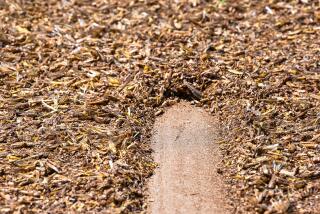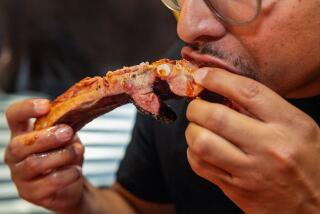Expensive Feed, Bigger Herds Pinch Livestock Farmers
- Share via
VICTORIA, Ill. — Jerry King, a longtime hog farmer in central Illinois, surveys his thousands of grunting animals, grits his teeth and searches for ways to fend off soaring feed costs.
While many suggest simply selling his animals now rather than fattening them for market later, King stands defiant.
“We can’t shut down,” he said. “It’s not like another industry where you can close your doors for a couple of weeks until your inventory is gone. We don’t have a choice. We just have to try to operate more efficiently.”
The government has reported the biggest hog herds since 1980, a tribute, at least in part according to the Agriculture Department, to the advent of air-conditioned hog barns that prevented the summer’s heat from reducing conception rates and litter sizes. At the same time, cattle pens and chicken coops are also bulging.
The recent reports of growing hog, cattle and poultry supplies are likely to result in continued strong domestic feed consumption at a time of tight supplies and brisk export sales. Farmers in past years of lean corn stocks would feed low-grade wheat or sorghum, but this year these too are in high demand.
On Dec. 28, corn prices hit a 12-year high of $3.6925 a bushel and are poised to continue the rally, perhaps surpassing $4 a bushel.
“I’m certainly not getting out of my long positions at $3.80” a bushel, a long-time price target, said Terry Roggensack, grain analyst at Hartfield Trading Partners in Chicago. “$4.50 would not surprise me as an extreme for corn.”
The really smart traders are doing a spread trade--betting on higher corn prices and lower hog prices.
*
While big export sales to China and Japan, where demand is also reported higher this year, can send prices higher, the U.S. livestock industry remains the backbone of the corn market. The United States is expected to consume 61% of last year’s 7.37 billion bushel harvest. Exporters, in comparison, sell 28% of corn production abroad.
In times of lean inventories, traders have relied on rising feed prices to force the livestock industry to reduce corn usage, effectively easing supplies. That’s projected to happen, with the USDA estimating feed corn consumption in the marketing year, which ends next fall, to plunge 18% to 4.53 billion bushels, from 5.53 billion last year.
While consumption is seen shrinking, however, animal herds keep growing. The number of cattle being fattened for slaughter Dec. 1 was up 2% from a year earlier, to 9.07 million head, a herd that’s among the largest in 20 years, according to the USDA. At the same time, U.S. hog farms contained 60.19 million head, up 0.3% from 1994 and the largest since 1980, the department reported last Wednesday.
“Something has got to give,” Roggensack said.
That started recently when hog prices plunged at the Chicago Mercantile Exchange while corn prices soared, continuing to squeeze margins for hog producers. Meanwhile, the price of young cattle ready to be placed on feedlots plunged to 61.205 cents a pound, the lowest in nine years, indicating sagging demand for fresh supplies.
Still, a rebound in hog prices from a year ago has allowed farmers to continue feeding animals expensive corn and turn a profit. Even with last week’s drop, live hog futures are about 30% higher than a year ago, wobbling near 49 cents a pound.
That gain, coupled with abundant retail and overseas demand for pork, has encouraged farmers to continue feeding animals.
“I think we’ll see prices head higher,” said Ellen Hankes of Fair Bury, Ill., who markets about 10,000 hogs a year. “We’re not shrinking our herd.”
*
Corn supplies worldwide are at 20-year lows, and export demand is keeping prices high. Some contend that the high price is already deterring farmers from buying corn for feed. Mickey Luth, grain analyst at Merrill Lynch & Co. in Chicago, said rising hog and cattle herds and intentions to continue breeding have happened before in lean supply years.
While raw animal numbers are increasing, they’re being fed less and sold for slaughter at lighter weights, which translates to less corn use.
“Everybody is focusing on the livestock numbers,” he said. “It’s not the actual number of livestock but feeding rates per animal” that translate to lower use.
More to Read
Sign up for Essential California
The most important California stories and recommendations in your inbox every morning.
You may occasionally receive promotional content from the Los Angeles Times.













